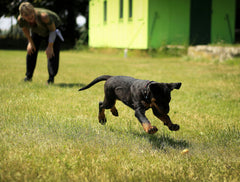
There shouldn’t be too many people out there who wouldn’t be able to instantly recognize the Saint Bernard dog if they were to encounter one in real life or even see it on television. The Saint Bernard is an iconic dog both in reality as well as on the big screen. From legendary pictures of these massive dogs trekking through miles of snow with a tiny barrel strapped around their neck, to classic movies like Beethoven. The Saint Bernard has certainly made a place for itself in Hollywood and History.
History

This Switzerland native breed is said to be a mix between a breed of dog that was native to the Alps and a Mastiff. For quite some time, the dog that would later be known as the Saint Bernard, would be grouped into a group of dog breeds, all known as “Baur hounds” until sometime after 950 AD.
After Archdeacon Bernard de Manthon Traveled through this pass and created a place where he could help tired travelers. Eventually, Baur hounds were utilized in this place of rest. There’s much speculation as to what these large dogs were used for here. Some historians say they were likely acting as guard dogs.
Although, there is also the belief that the residing monks would take the dogs with them when they went out in search of weary travelers. The Baur hounds would prove to be excellent pathfinders in addition to having high endurance levels. Records show that the Saint Bernards of this time were responsible for at least 2,500 rescues of lost or exhausted travelers.
In England, these massive dogs were referred to as “sacred” and were bred with the English Mastiffs to invigorate the already large breed. It wasn’t until the late 1880’s that the breed had begun to be accepted into kennel clubs around the world. Now, they are a common family dog in addition to being a well-known and accomplished breed in Hollywood.
Temperament

Saint Bernard dogs have the same friendly and welcoming personalities that they became so famous so long ago. They are also great around children. The Saint Bernard has a gentle and patient temperament around children. They will enjoy playing and running around but will not pose a threat to a child’s safety.
If you and your family decide to adopt a Saint Bernard puppy, be sure to expose them to early socialization. Exposing your Saint Bernard puppy to a variety of people, environments, and even sounds is very beneficial.
Diet

A Saint Bernard will usually do well on a diet of high-quality commercial dog food. Specifically, the kind of dog food that is formulated for larger breeds of dogs. Many dogs can become overweight easily. This is why it’s important to moderate the amount of food that your Saint Bernard takes in while also keeping tabs on their weight and physique. The St. Bernard weight should generally stay somewhere around 140 to 180 pounds in order to be classified as having a healthy weight.
Since Saint Bernards are known to develop allergies sometimes, you may consider taking up the task of making them homemade dog food rather than continuing with the game of trial and error with store-bought food. Making homemade dog food for a dog with allergies can often be exactly what they need. However, it’s important to bring this up to your Saint Bernard's vet before switching their diet. That way their vet can be on board to make recommendations and keep track of their progress with their new diet.
Health Problems

Hip dysplasia is a common health complication among many different breeds of dogs, including the Saint Bernard. When you arrive at the Saint Bernard rescue, you can ask the caretakers there if the Saint Bernard that you intend to adopt has ever experienced any problems with hip or elbow dysplasia before.
There are a number of other health problems that Saint Bernards have been known to face. Such as Epilepsy, Dilated Cardiomyopathy, Cataracts, and allergies. These are all problems that you can talk to the Saint Bernard rescue or breeder about before you adopt a Saint Bernard of your own. A breeder should be able to give you a health history of the parent dogs as well as the puppy.
Health problems such as Epilepsy can sound scary and intimidating for a dog lover who has not yet encountered a dog with these diseases in their lifetime. Epilepsy can be controlled with medication and proper overall care, allowing your Saint Bernard to live a long and healthy life. Dilated cardiomyopathy, on the other hand, is a more severe and life-threatening condition. It can be treated with a good diet, medication, and rest, but the outcome doesn’t always look so good with this condition.
Conclusion
There’s really nothing negative that can be said about the Saint Bernard dog breed. Their name really says it all - “saint” Bernard. Throughout history this breed has been doing the work of saints by helping monks in the Alps rescue and care for lost and weary travelers. Their gentle and friendly temperament makes the Saint Bernard a wonderful family dog who will love and protect their family for as long as they will live.
Do st bernards shed?
How big do Saint Bernards get?
How long do Saint Bernards live?
Related Posts:
- Hound Dog Breeds: Know These Awesome Dogs
- Do Small Dogs Live Longer Than Big Dogs?
- Here Are the 5 Best Large Dog Breeds




